One Plane Golf Swing
vs. Two Plane Golf Swing - What's the Difference?
As I mentioned, Jim Hardy
(learn
more) was the first to come
up with the idea that there are two sets of fundamentals
in golf. I agree, that at its most
basic form, there are only two types of golf swings
- a one plane swing and a two plane swing.
While there are thousands of variations
of each swing, every golfer can be classified as
one or the other. If you don't know which you are,
then that helps explain part of the reason why you
are struggling. As Hardy put it, the two swings
are like oil and water, they don't mix. He advocates
that you can't take parts from a one plane swing
and put them into a two plane swing. Unfortunately,
little information is available to the golfing public
on the differences of the two swings so there is
a lot of confusion with golfers hearing conflicting
tips on the golf swing. Every swing guru today has
his or her trademark "tips" that they
use to differentiate themselves and their tips often
conflict with another swing guru's opinion of the
swing. There is nothing more frustrating for a golfer
than reading an article in a magazine from one instructor
who says one thing and then to turn a couple pages
to another article that says the exact opposite.
It is this exact scenario that led me to launching
this website, to help educate golfers on the two
sets of fundamentals in the swing that Jim Hardy
came up with and to bring together a public forum
for learning, after all, we are all just students
of the game. In explaining how the two golf swings
actually work, accoring to Hardy, rather than try
and give you tips to help "fix" your golf
swing, hopefully you will finally understand the
golf swing for what it really is.
Jim Hardy explained that the simplest way
to think of the differences between the two swings
is this: In a two plane swing, the arms and shoulders
swing on two different planes, in a one plane swing
they are on the same plane. For the two plane swing,
imagine Davis Love III or David Toms. Their arms
swing more upright while their shoulders rotate
fairly level. For the one plane swing think of Ben
Hogan, David Duval or the new Tiger Woods. In general,
the swings are more around with the arms swinging
on the same plane as the shoulders.
The following is based completely
on what I interpreted Jim Hardy to be saying on
The Golf Channel, as well as my interpretations
of Ben Hogan's Five Lessons and my own personal
experience and is meant solely for educational purposes.
|
TWO PLANE
GOLF SWING
Setup
The spine angle tends to be more upright at address
in a two plane swing. This erect address position
causes the shoulders to rotate on a relatively flat
plane, more level to the ground. Some two planers
will have the appearance of a more bent over spine
angle at address due to the rounding of their shoulders,
but they will usually rotate their shoulders on
a more level plane, perpindicular to their spine.
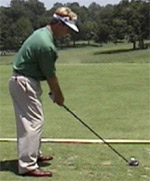
David Toms has a beautiful upright address position
with his arms dropping more straight from his shoulders.
This will cause them to swing more "up"
on the backswing.
Backswing
The biggest difference in the two swings is seen
here. The arms swing up on a more upright plane
than that of the shoulders and the club swings well
above the plane and to the outside of the turn.
In order to do this, the left arm must disconnect
from the left chest muscle and then reconnect on
the downswing. Also, there is a more pronounced
shift of the body to the right creating the need
for a greater lateral move back to the target during
the transition. This shift creates width in the
backswing which is necessary because of the tendency
to be too narrow with the arms swinging more up
than around.
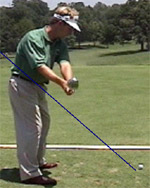
David's club has clearly traveled up above the plane
very early in the swing. His arms are now moving
independently of his body.
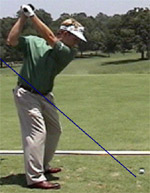
David in the perfect two plane
position at the top. His arms have a long way to
go to get the club back on plane. Tiger Woods used
to get in the same position at the top as seen here
in 2001, but no more. He is moving more to a one
plane swing with Hank Haney.
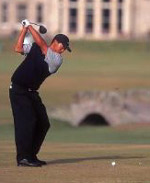
Transition
This is where things get tricky. Swinging the arms
up on a more vertical plane than the shoulders requires
that, at some point in the swing, the arms must
drop back down on plane before the rotary motion
of the body can be used to generate power by aggressively
rotating back to the left. In order to do this,
there needs to be either a lateral move toward the
target with the body that gives the arms time to
drop back on plane before the body begins to clear
left, or the hips must simply "wait" to
turn until the arms have dropped the proper amount.
This information is not new or profound, the top
teachers of today have all taught that the arms
must have time to drop before you can turn, and
a bit of common sense would let you know that if
your arms are high above your head and you are wanting
to hit an object on the ground while your body is
turning, you have no choice. That is, unless, of
course, you want to drive the ball straight down
into the ground. You've no doubt seen drills that
talk about dropping the right leg back (for righties)
so that you can slow the rotation of the body. As
you can imagine, trying to time these moves consistently
proves very difficult over time. This places a high
demand on timing and rhythm, which vary from day
to day. In a one plane swing, you will see that
the inconsistencies that are caused by this motion
are far less of an issue. Although, I don't believe,
that timing and rhythm are things that can be disregarded
in either swing.
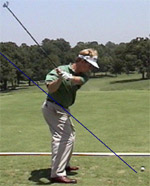
Too steep to hit the ball at
the target, David will continue to "wait"
for arms to fall back on plane.
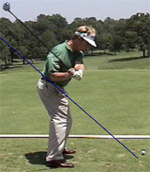
David's arms have dropped dramatically to get the
club back parallel to the plane, but still above
the shaft plane he established at address.
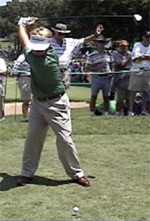
Toms "loads up" more
on his right side rather than having an aggressive
transition. He must do this to give his arms more
time to drop back on plane. If he rotated as early
and aggressively with his body as Flesch does, the
arms would have no time to get back on plane and
they would be stuck behind him.
Downswing
It is critical for the arms to drop back down on
plane before the body begins to rotate back to the
left. Many two plane golf instructors teach a "looping"
motion in the swing where the club swings up on
the backswing and is then "flattened"
on the downswing in order to get the club back on
the proper plane. Jim Furyk is an extreme example
of this, but all two planers must due this to some
degree. The difficulty is getting the amount of
drop correct as well as the timing of the drop,
not to mention the patience required to not "hit"
the ball from the top of the swing - where the body
begins rotating back to the left before the arms
have dropped. Those that don't resist the "hit"
urge and begin rotating back to the left before
the arms drop on plane will swing "over the
top" if the arms didn't drop at all or be in
a "stuck" position if the arms didn't
get back in front of the body.
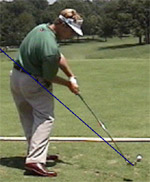
David's hands are well above the plane nearing impact
and his right arm is "stuck" behind his
hip. Toms' swing is a bit unique in that he uses
his body more than his arms on the downswing than
most two planers, but for most golfers, this ball
goes well right. It would for David, too, if he
didn't have a unique move at the top where he deliberately
bows his left wrist, in essence closing the clubface
so that he can play from this "stuck"
position. It's a unique move that takes the timing
out of the hands.
|
ONE PLANE
GOLF SWING
Setup
The spine angle is more bent over at address allowing
the shoulders to rotate on a steeper plane. This,
in turn, allows the club to swing up. Ben Hogan,
the classic one planer, stood more erect at address
and then swung his shoulders on a steeper plane
during his swing. The more tilted the spine angle
, the less the arms will swing "up" above
the shoulders on the backswing.
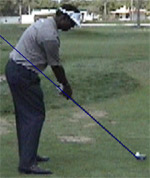
Vijay Singh has a bit steeper spine angle than David
Toms and has his arms out away from his body a bit
more. This will create a more "around"
swing path.
Backwing
In the one plane swing, the shoulders and arms swing
on very much the same plane. There are far fewer
"moving parts" because the left arm never
leaves the chest to swing up on a steeper plane.
Because the swing is more "around" than
"up", Hardy teaches that the body may
stay more to the left with less lateral shift to
the right, although, in my opinion this reduces
power. It does reduce the need to have a large slide
back toward the target during the transition, however.
But it also takes some of the power out of the swing
that can be generating by using the lower body.
Hogan made less of a dramatic shift to the right
than many golfers, but Hogan also didn't hit the
ball as long as many of his contemporaries.
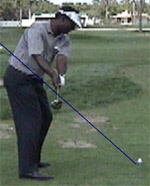
Vijay swings the club more around on a more natural
swing arc. His arms have done nothing independent
here, they are simply following his body's lead.
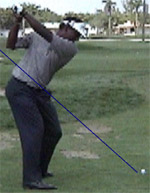
Vijay's left arm and shoulder match up very much
on the same plane at the top. But nobody matched
up as well as Ben Hogan. Hogan's left arm and shoulders
were perfectly on plane, exactly parallel with each
other, while Vijay is slightly above. In my opinion,
this allows Vijay to make a more powerful swing
than someone who keeps their left arm below the
shoulder plane.
Hardy also said that
the arms should swing as "far behind you"
as you can get them. In my own experience, this
advice is something that can be "overcooked".
The arms should be allowed to swing behind
you, but swinging them back as far as possible for
a person with a lot of flexibility like my self
causes me to overswing and creates tension that
causes my arms to "rebound" away from
my body, causing me to come at the ball from the
outside. It is my personal opinion that the arms
should be thought of to be "allowed" to
swing back behind you but that you should not try
and "get" them behind you as far as possible.
Transition
Because your arms are always on plane, there is
no waiting for them to drop. Your body can begin
to rotate back toward the target as aggressively
as you like and the arms will simply follow. The
natural instinct at the top of the swing is to get
the club head back to the ball as fast as possible
in order to strike it with authority. Of course,
this is the key detriment to swinging on two planes
where you simply must create some sort of delay
during the downswing to let the arms fall back down
on plane in a position to strike the ball. Hardy
points out that in a one plane swing, all you do
from the top is rotate the body back to the left.
Everything rotates together, reducing the dependency
on timing and rhythm to blend the upright swinging
of the arms and the flatter turning of the body.
Unfortunately, many golfers swing their arms "up"
on the backswing and then try and rotate their bodies
back to the left as hard as they can. In essence,
they are combining characteristics of the two swings,
which doesn't work and creates the over the top
move.
Hardy didn't speak a great deal on Academy Live
regarding the transition. I took what he said to
mean that once you swing back, you simply rotate
everything back to the left together. If you keep
your weight more favoring your left side, then this
could be true. However, in my opinion, this lack
of shift to the right and then back is exactly what
gives the top players in the world their power.
And, if they make a shift to the right, there must
be a transition where the shift back to the left.
While I agree with Hardy that you can solidly strike
the ball from swinging on just the left leg, I have
to disagree that the top golfers of today do this.
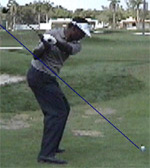
Vijay gets back parallel to the plane earlier than
Toms, and then matches up perfectly halfway down.
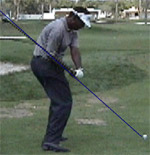
Back on plane, but Hogan never
strayed far from it. Vijay stays closer than most
today.
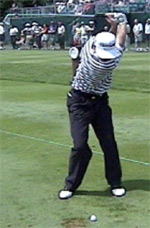
Steve Flesch's transition is
one of the best in the business. His aggressive
body rotation back to the left creates the look
of him hanging on his front leg, but this is simply
not true. His body began moving back to the target
before his club reached the top of the swing, creating
a tremendously dynamic position. Because his arms
are on plane, he can simply swing left, no waiting.
Downswing
In the one plane swing, the arms, club and shoulders
are already on the proper plane, or in my estimation,
much closer to it, allowing the golfer the freedom
to simply rotate the body back to the left. With
the left arm glued to the chest, the body can rotate
as hard it likes without ever worrying about trying
to control the arms. It is important that the golfer
properly use his body to swing the club and not
the arms. Golfers who are accustomed to swinging
their arms to generate power often find this one
of the biggest challenges. No longer requiring the
arms to try and control the club, the golfer can
do what he instinctively wants from the top of the
swing - swing hard. You'll quickly find that this
swing will feel completely natural, just like hitting
a baseball off a tee. A downswing mantra would be
"swing left".
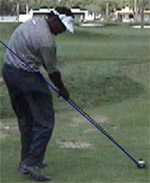
Not sure what to say here. Number one in the world,
one plane golf swing. Vijay works hard at keeping
his left arm glued to his chest throughout the swing.
You've no doubt seen him swing with a golf glove
under his left arm. That is a major key to the one
plane swing.
The principles that Jim Hardy has come up with make
a lot of sense and many of the great ball strikers
of today appear to follow closely to what he has
said, with variations here and there.
|
|
|
|
